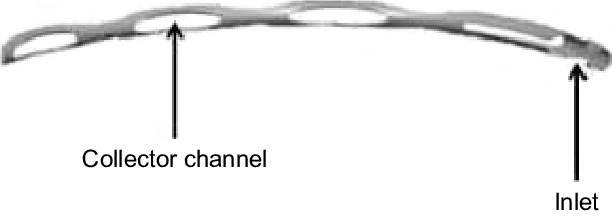The Hydrus Microstent is a MIGS device (Minimally Invasive Glaucoma Surgery) used at the time of cataract surgery to lower pressures in patients with glaucoma. It is one of the larger of the MIGS devices that exists on the market today.
Glaucoma is a medical condition where the pressure inside the eye is too high, leading to progressive optic nerve damage. To understand how the Hydrus Microstent works, think of a road with a long drain and sewer system along the entire side of the road. The grating of the drain is called the trabecular meshwork inside the eye, and the sewer system directly underneath the drain is Schlemm’s Canal. In this analogy, glaucoma would be an overflow of the storm water.
The Hydrus Microstent is inserted through the trabecular meshwork and threaded into Schlemm’s canal. As a stent, it opens up Schlemm’s canal and allows fluid to more easily exit out of the eye. It also has three Collector Channels (see image above), that provides a scaffolding system to improves the flow through the trabecular meshwork.
The length of the Hydrus Microstent covers approximately 1/4 of all of Schlemm’s canal, so a significant area could potentially be improved. The majority of the Hydrus Microstent is buried in Schlemm’s canal, and only a small area of the Inlet (see image above) is exposed. It is small enough, however, that it typically cannot be seen in the eye without a microscope.
The FDA has approved the use of this device to treat mild and moderate stages of glaucoma. As of this writing, insurance companies will only pay for the insertion of the Hydrus Microstent if it is done at the same time as cataract surgery. If you do not need cataract surgery, or if you have already had cataract surgery, the Hydrus Microstent would be considered a non-covered procedure.
If you have glaucoma and need cataract surgery, ask us here at the San Jose Eye Institute if the Hydrus Microstent is the right MIGS device for you.
